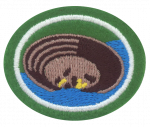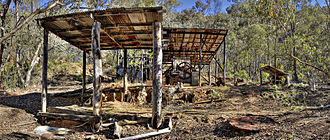Difference between revisions of "AY Honors/Gold Prospecting/Answer Key/es"
(Created page with "{{clear}}") |
(Created page with "{{clear}}") |
||
| Line 243: | Line 243: | ||
{{clear}} | {{clear}} | ||
| − | + | {{clear}} | |
==== Major and long lasting impact ==== | ==== Major and long lasting impact ==== | ||
Revision as of 03:27, 25 January 2021
| Prospección de oro | ||
|---|---|---|
| Asociación General
|
Destreza: 1 Año de introducción: 2008 |
|
Requisitos
|
La especialidad de Prospección de oro es un componente de la Maestría Recreación. |
1
1a
1b
1c
1d
1e
1f
1g
1h
1i
1j
1k
1l
2
2a
2b
2c
2d
2e
2f
2g
2h
2i
2j
2k
2l
2m
2n
2o
2p
2q
2r
3
3a
3b
3c
4
5
Major and long lasting impact
Australia's population changed dramatically as a result of the rushes. In 1851 the Australian population was 437,655, of which 77,345, or just under 18%, were Victorians. A decade later the Australian population had grown to 1,151,947 and the Victorian population had increased to 538,628; just under 47% of the Australian total and a sevenfold increase. In some small country towns where gold was found abundant, the population could grow of over 1000% in a decade (e.g. Rutherglen had a population of ~2'000. Ten years later, it had ~60'000 which is a 3000% increase). The rapid growth was predominantly a result of the gold rushes.
The gold rush is reflected in the architecture of Victorian gold-boom cities like Melbourne, Castlemaine, Ballarat, Bendigo and Ararat. Ballarat has Sovereign Hill — a 60 acre (240,000 m²) recreation of a gold rush town — as well as the Gold Museum, while Bendigo has a large operating gold mine system which also functions as a tourist attraction.
The rushes left the legacy of quaint Victorian towns in the Goldfields tourist region like Maldon, Beechworth, Clunes, Heathcote, Victoria, Maryborough, Daylesford, Stawell, Beaufort, Creswick, St Arnaud, Dunolly, Inglewood and Buninyong. With the exception of Ballarat and Bendigo, many of these towns were substantially larger than they are today. Most populations moved to other districts when gold played out in a given locality.
At the other end of the spectrum ghost towns, such as Walhalla, Mafeking and Steiglitz still exist.
The last major gold rush in Victoria was at Berringa, south of Ballarat, in the first decade of the 20th century. Gold mining ceased in Victoria, not because there was no more gold but in part because of the depth and cost of pumping. The First World War also drained Australia of the labour needed to work the mines, but worse the prohibition on the export of gold from Australia in 1915, the abolition of the gold standard throughout the Empire, saw many goldtowns in Victoria die. The slump in gold production never recovered. However, as of 2005 the recent increase in the gold price has seen a resurgence in commercial mining activity; mining has yet to be resumed in Bendigo, while some is occurring in Ballarat, and exploration proceeds elsewhere, for example, in Glen Wills, an isolated mountain area near Mitta Mitta in north-eastern Victoria.
6
6a
Most states in the U.S. have areas where gold can be located. The best way to meet this requirement is to go to an area and actually dig up the material and pan it there. It would be best for the instructor to scout the area first and find a location where there is at least some gold available, ideally there should be at least a few flakes or specs of gold in each pan.
Another way to meet this requirement is for the instructor to get some gold bearing material and then have the students pan it in some type of trough, the plastic pans available at your local hardware store for mixing mortar work well. You can also build a panning trough out of 2x10 lumber with a thin plywood bottom and line it with plastic.
You can also purchase black sand concentrates from various locations on the Internet. These can be mixed with sand and gravel from a local river or stream bank and then used for panning. When panning don’t fill the pan completely full. It is easier, especially for beginners to start with a pan that is 1/2 to 3/4 full. You may also want to drop a small lead weight like a fishing weight into the pan. If the lead is still in the pan when the pan is down to just black sands then you can be sure that the gold is still there also.
6b
Get some sand and gravel, from a river or stream bank if possible, and mix in a specific number of flattened lead or tungsten shot. Tungsten shot would be the best choice for two reasons if you can find it. First unlike lead, tungsten is non toxic, and second, while lead at 11.3 is only about half the specific gravity of gold, tungsten is almost identical at 19.62.
7
7a
44The kingdom of heaven is like treasure hidden in a field, which someone found and hid; then in his joy he goes and sells all that he has and buys that field. 45Again, the kingdom of heaven is like a merchant in search of fine pearls; 46on finding one pearl of great value, he went and sold all that he had and bought it.
This verse suggests that it is perfectly acceptable to prospect for high value items. God wants us to be financially successful. The kingdom of heaven, like high value treasure, is worth having.
7b
19Lay not up for yourselves treasures upon earth, where moth and rust doth corrupt, and where thieves break through and steal. 20But lay up for yourselves treasures in heaven, where neither moth nor rust doth corrupt, and where thieves do not break through nor steal. 21For where your treasure is, there will your heart be also.
Here Jesus covers the flip side of earthly treasure. Putting earthly wealth ahead of heaven is disaster. As in most things, Christians need to seek a reasonable balance on earth and put the emphasis on heavenly things.
References
- Categoría: Tiene imagen de insignia
- Adventist Youth Honors Answer Book/Honors/es
- Adventist Youth Honors Answer Book/es
- Adventist Youth Honors Answer Book/Skill Level 1/es
- Categoría: Libro de respuestas de especialidades JA/Especialidades introducidas en 2008
- Adventist Youth Honors Answer Book/General Conference/es
- Adventist Youth Honors Answer Book/Recreation/es
- Adventist Youth Honors Answer Book/Recreation/Primary/es
- Adventist Youth Honors Answer Book/Stage 0/es
- Adventist Youth Honors Answer Book/Recreation Master Award/es
- Adventist Youth Honors Answer Book


